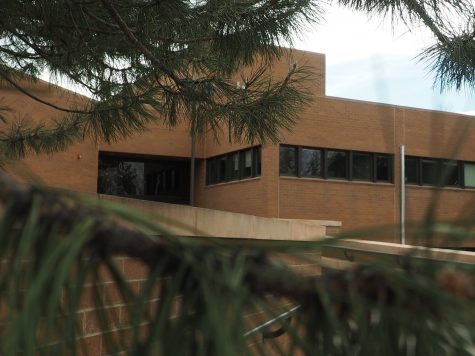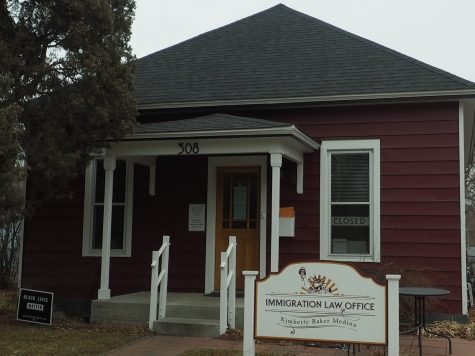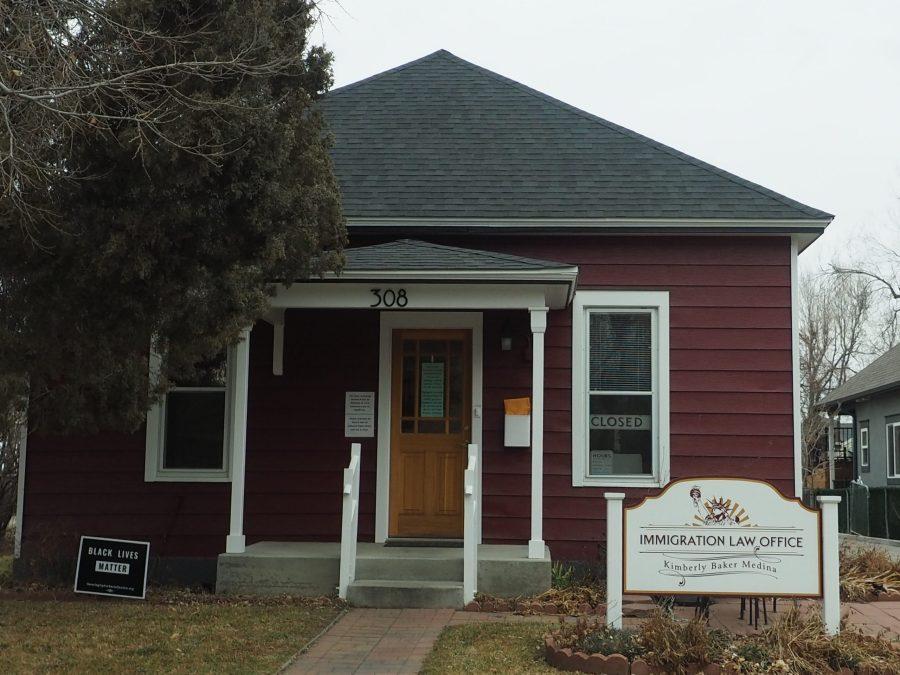Fort Collins works to preserve City’s Black landmarks
Immigration Law Office of Kimberly Baker Medina on Feb. 6. This building was the former residence of the Thomas family. After moving to Eaton in 1910 where they had their son Virgil, John and Mamie Thomas moved to this house in Fort Collins around 1930. Mamie worked as a cook for the school district and Virgil went to Fort Collins junior high and high school. Virgil became a star offensive lineman on the team and would later go on to accept a football scholarship from Wilberforce College in Ohio and later would serve in the European theatre of World War II, fighting as an infantry corporal in Italy and Germany. John Thomas stayed in that home with his wife Mamie until he passed away around 1968. (Gregory James | The Collegian)
February 10, 2021
The City of Fort Collins Historic Preservation department created a website outlining narratives around Black historic locations within the city in an effort to preserve the sites as city landmarks.
Deeper historical research into the Black history of Fort Collins began this past summer with the resurgence of the Black Lives Matter movement and the events following the tragic death of George Floyd.
Jim Bertolini is a historic preservation planner who works for the City and has played a major role in putting together the Black historic preservation project.
“The resurgence of Black Lives Matter was forcing some conversations about Black history and how it is not told a lot,” Bertolini said.
As a result of this, not many people understand the true role that African Americans played in building communities, including in Fort Collins. It was an untold story and the duty of historical preservation is to revive that voice, Bertolini said.
Reviving the past
Bertolini and his team already knew small amounts of Black history but conducted a lot of archival research and looked through City records and censuses to uncover all the stories.
Bertolini crafted the website with the model that they had successfully mastered with the women’s suffrage project from a few months before.
Bridgette Johnson, managing director of Diversity, Equity, Inclusion and Student Success and former director of the Black/African American Cultural Center at Colorado State University, reached out for a partnership on the Martin Luther King Jr. Day celebration and the historic preservation team was able to put together all the research into this honorable website, Bertolini said.
Bertolini and his team put in hours of their own time to research and patch together the narrative framework for all these stories and locations.
What we wanted to do was make sure people knew that there was a geography to Black history in Fort Collins.”-Jim Bertolini, historic preservation planner
Most notably, the preservation team found the story of Mattie Lyle, a Fort Collins woman who sued the State Theatre for discrimination and won in 1939.

Lyle was the first person ever in Larimer County to sue on the basis of discrimination, and she won with a unanimous decision by the jury.
“(We had) some lucky connections with people, including Lyle’s grandchildren, who live in Seattle now, (and were) tremendous help in offering letters and family photos and things like that,” Bertolini said.
The website that launched on MLK Day is intended to be a part of a larger goal within historic preservation of telling the untold stories and bringing different perspectives to light for the history of Fort Collins.
The website features instructions for a walking tour of the city that includes several historical Black monuments and structures from north and west Fort Collins to the CSU campus for the public to explore and learn about — for example, the now-demolished Clay family homes that used to be on the north end of Washington Park by City Hall.
“What we wanted to do was make sure people knew that there was a geography to Black history in Fort Collins,” Bertolini said.
The Historic Preservation team wants to conduct more formal research that goes more in depth to completely retell the story of Black lives in Fort Collins that get routinely forgotten.
Maren Bzdek is a senior historic preservation planner at the City of Fort Collins Historic Preservation department. Bzdek worked alongside Bertolini to do the research and planning that went into the website honoring Black history in Fort Collins.
The road to preservation
Historic Preservation is a division of the Community Development & Neighborhood Services department and is there to recognize and protect properties that are significant to the history of Fort Collins.
“We use places to tell the stories of Fort Collins,” Bzdek said. “And we do it in such a way that hopefully, it creates an environment where everybody feels a sense of belonging based on being able to connect with our history.”
Fort Collins has many gaps within its Black history: From 1870 to 1930, there were little to no records of Black families or culture.
Bzdek hopes that the project serves a dual purpose: Not only does it help to inform community members, but it works to create change by officially recognizing these uncovered locations as historic landmarks. In Fort Collins, there are currently around 300 historic landmarks, but none of them are directly associated with Black history, Bzdek said.

“One of the things that we do by creating the kind of web content that we did and the virtual tour is we set up the possibility for that to change by bringing the community up to speed on where those places are,” Bzdek said.
To designate a landmark, the property owner has to make the decision and go through a specific process, which includes providing a reason for designation. The issue is then brought before City Council, where they will vote on an ordinance officially recognizing the landmark.
Once the property becomes a landmark, it cannot be destroyed, and the owner has access to funds that can be used to take care of the property and ensure its longevity.
There is a nationwide effort to uncover and preserve historic Black locations and properties. The National Trust for Historic Prevention’s African American Cultural Heritage Action Fund is an organization that works to help communities find, verify and get funding for historic Black locations. Their goal is to tell the full American story by supporting those who have not had a voice in the past.
The funding associated is an advancement for equity and meant to catch up with all the lost time.
“Here at the local level in Fort Collins, we’re trying to do our part to make sure that we’re part of that nationwide effort,” Bzdek said.
Preservation in action
Kim Medina, a local attorney who specializes in immigration law, owns the Thomas residence on 308 Cherry St. Medina purchased the house and renovated it back in 2013 to use as an immigration law office.
“We wanted a place that felt comforting and homey, so we chose a home and we liked that neighborhood,” Medina said.
Medina inquired with the City upon purchase of the home to see if it had historical significance, but by the standards of architectural and social significance, the property did not qualify as historic.
Through the investigative work of the historic preservation department with Bzdek and Bertolini, Medina was able to learn the true significance of her office.
Ultimately, the state of Colorado should develop a statewide civil rights context, a statewide African American’s history context.”-Maren Bzdek, senior historic preservation planner
The office was home to Virgil Thomas, one of few Black people to attend Fort Collins High School in the late 1930s. Thomas was the only Black athlete on the Fort Collins High School football team; he was one of the best players on the team as star left tackle for the offensive line. In his free time, Thomas was a boxer and starting pitcher for the Fort Collins softball club.
Thomas earned a football scholarship to Wilberforce College in Ohio and left Fort Collins in 1941. Thomas went on to serve as an infantry corporal during World War II, serving in Germany and Italy.
“That was very exciting to us, and so we asked the City if we could try to landmark the house to honor the family that lived there and to honor the young man who had attended Fort Collins High School and have played football there,” Medina said upon discovering the true history of her office.
If the home on 308 Cherry St. makes it through the process, it will be the first landmark in Larimer County associated with Black historic significance.
“I did the walking tour with my mother, and some of the houses on the tour have been torn down,” Medina said. “It’s tragic.”

Medina stressed the importance of honoring history of not only the white and wealthy but of the lower class diverse identities that typically don’t get the mantle. She wants to honor the history of Indigenous Americans, African Americans and immigrants.
Bzdek stressed that these actions were more than performative for MLK Day and Black history and that they are an avenue toward institutional change.
“Ultimately, the state of Colorado should develop a statewide civil rights context, a statewide African American’s history context,” Bzdek said.
Although the Black history in Fort Collins is limited, the stories deserve to be told as these small communities contributed so much to the advancement of diversity and culture in Fort Collins.
“It was small but mighty, like, these people do really interesting things,” Bzdek said. “Each person was significant in their own way, each one of them is very, very powerful actors in their community.”
Isaiah Dennings can be reached at news@collegian.com or on Twitter @isaiah_dennings.







